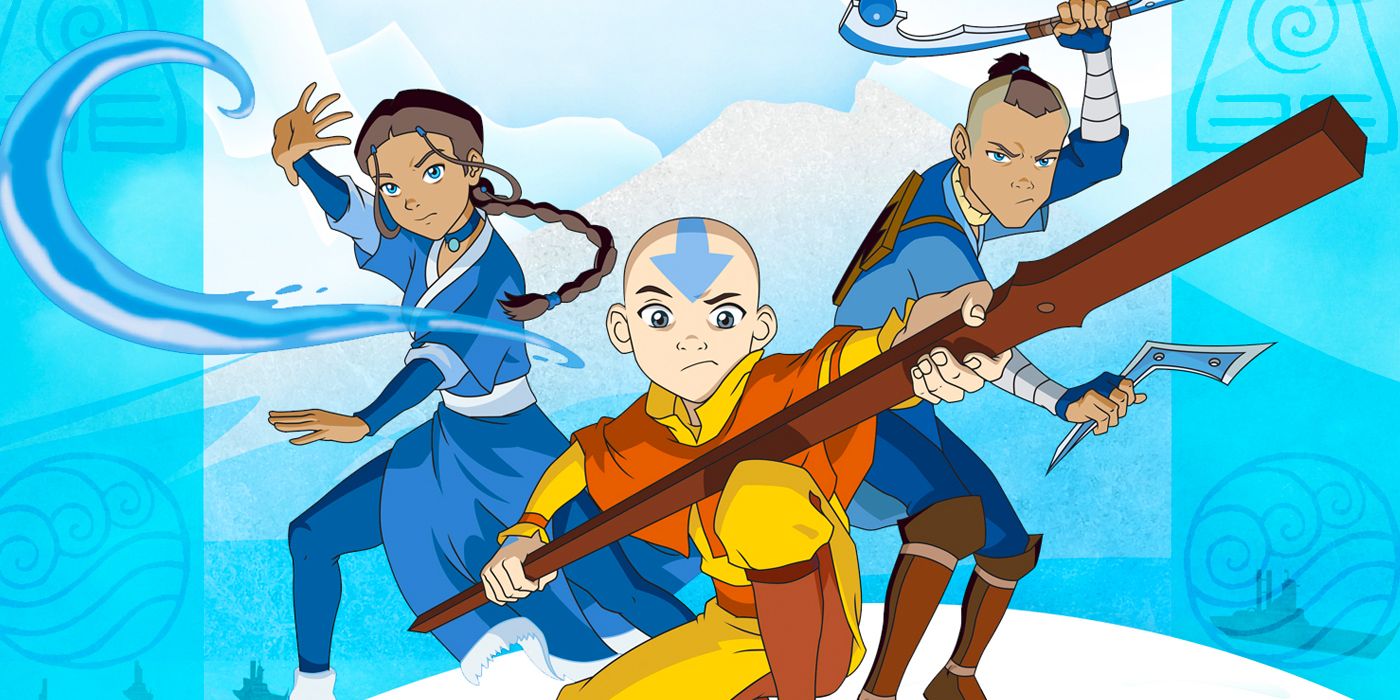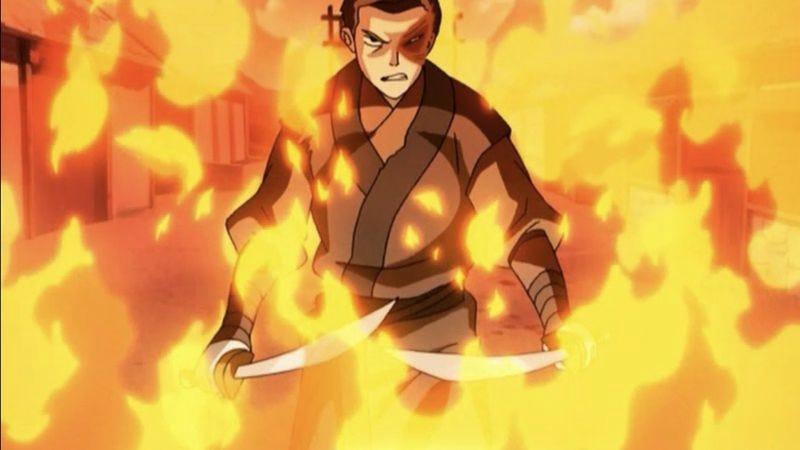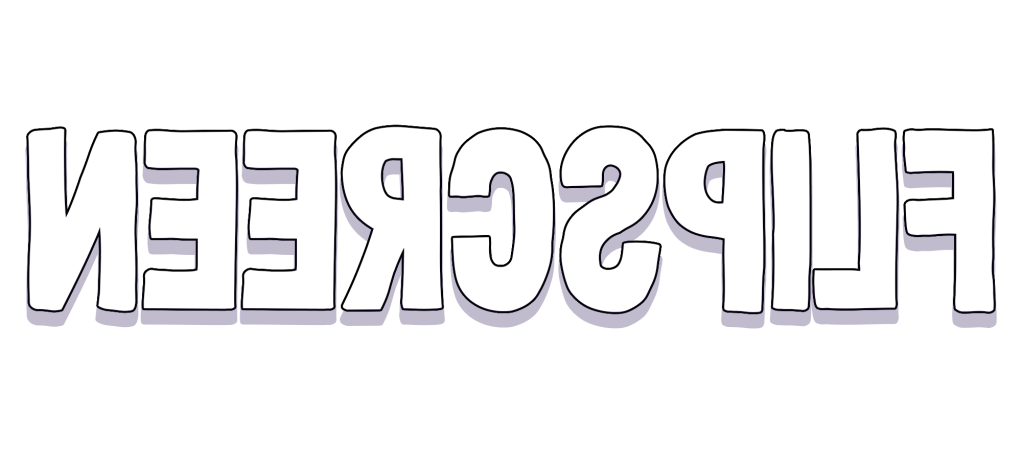Avatar: The Last Airbender aired its final episode on July 19 2008, and is regarded as one of the best Nickelodeon and children’s’ programs of all time, even winning an Emmy. I spoke to Giancarlo Volpe, a director of the animated series, who won an Annie award for his work on the episode “The Drill,” about his thoughts on animation being labelled ‘for kids’ and the secrets to the series’ success.
Avatar: The Last Airbender is divided into four ‘Books,’ or seasons, which deal with a different element. Aang (Zach Tyler Eisen) is the Avatar, a reincarnated being who can master all four elements and whose purpose is to bring balance to the world. The world is also split into four: the Earth Kingdom, the Fire Nation, the Water Tribes and the Air Nomads. Aang’s people are wiped out in a genocidal attack by the Fire Nation in an attempt to find and kill the Avatar and take over the world. Aang flees and is frozen in ice for 100 years before being unearthed. The series follows his and his friends’ adventures as they attempt to help Aang master all four elements and bring balance to the world.

Harry Robertson: Avatar: The Last Airbender was a hugely successful show: it had an average of 3.1 million viewers each new episode and was the highest rated animated television series at its premiere. And yet, for so many of its viewers, it didn’t seem like your typical ‘kids show’, as it tackles subjects such as genocide and authoritarianism. Do you think when we use phrases like ‘kids TV’ or ‘that show is for kids’ it’s detrimental to not only our expectations but also what’s possible from television aimed at children?
Giancarlo Volpe: I don’t agree that animation is only for kids. If anyone watches enough of it, they quickly learn it’s as capable of handling adult subject matter as live action. I’ve been told that the push for kid-friendly content comes from the fact that the top-grossing animated films of all time were family comedies. The studios keep pushing for more of this to turn a blockbuster-sized profit. I was glad that we got to challenge that preconception on Avatar. The show still feels very charming and safe for kids to watch, but the storytelling sensibilities are very mature. I hope that shows like Avatar will help viewers change their perception of what animation can be.
HR: The world of The Last Airbender feels like such a real place; it has depth and real-world inspirations to help ground it in our understanding. What were some of the ways you went about making it so vivid?
GV: Every culture was defined by their bending style. The airbenders, for example, have temples in high, hard-to-reach locations that one couldn’t access unless they could fly or glide. The waterbenders live around snow and water, and would create tall ice structures and fortresses. Firebenders utilize a lot of metal and mechanical ships because they could melt the metal, forge it into weapons and power it with fire, etc. It also helped that our Kung Fu advisor, Kisu, helped come up with a different real-world style of Kung Fu for each element. It really made every location feel unique. All of that discussion trickled down into the art direction of the show. It really just required a lot of thought and planning.
HR: After the ending of Book 2, Aang wakes up to find that he has lost connection to the Avatar state and has to abandon his glider. It was a shock to see such an optimistic character like Aang have to change and try and find himself again. How planned out were these emotional arcs for the characters and how important was it to you that all the main characters be rounded, three-dimensional people?
GV: It’s incredibly important! I can get frustrated when I work on shows (or watch shows) that don’t feel very well-thought-out or planned. On Avatar we always had a clear sense of where we were headed, which is thanks to how well planned out the series was. I remember Bryan Konietzko telling me stories about season three when we were still working on season one. Further seasons weren’t even greenlit by the studio yet. Ideally especially the main characters will go through a major change between the first and last episodes of a series. Remember also, one of Aang’s flaws was that he never really wanted to be the Avatar. Being taken down so harshly at the end of season two really forces him to act. By the time he finally confronts the Fire Lord you can tell he really owns his title as the Avatar.

HR: Even though Aang is the hero of the series, Zuko’s story of redemption runs parallel to Aang’s story and often, to me at least, steals the show. When Zuko and Iroh meet each other again in “The Old Masters,” it’s such a powerful moment to see Zuko’s journey come full circle. Could you talk about how that moment came about, and why you think Zuko’s story speaks to so many people?
GV: I often think the main character of animated shows can’t be too flawed because development executives won’t allow it. They get worried that they’ll be too unlikeable and fear this will be off-putting to potential viewers. Oftentimes we have to make a secondary character the truly flawed one, which is exactly what happened with Zuko. Starting him in a terrible place gives him more room to grow, which is why his character arc is more extreme than, say, Aang’s is. Part of the fun of Zuko was watching Iroh mentor him. When they get separated, you get a chance to see how Zuko fares on his own: did all Iroh taught Zuko actually stick? I think that’s why the reunion works so well — they’re relieved to see that each other is okay and relieved they’re both on the right side of history, thanks to Iroh’s guidance.
HR: Zuko and Azula’s Agni kai and final battle was such an epic way to end the series, alongside Aang’s battle with Fire Lord Ozai. In the early moments of Zuko and Azula’s fight the sound mix is reduced to just the flames and the soundtrack, and it creates this eerie feeling as the blue and red/orange flames collide in these awesome patterns. What was the thinking behind that decision?
GV:I didn’t direct that particular episode, but I’m assuming that decision was made by Mike and Bryan during the sound mix. I think it’s a cool trick to do during battles; you sort of slow down time for a second before the chaos of the rest of the battle ensues. It’s a bit like writing music: the slower parts provide contrast to the faster paced ones. It’s also a bit of a Kung Fu movie gimmick, but it was so perfectly implemented there. It helps build anticipation for what’s to come.
HR: One of the episodes you directed, “The Ember Island Players,” is very self-referential and almost works like a clip show. Did Nickelodeon, or the success of the show, give you a certain freedom to be self-referential in the humor of the show?
GV: By that point in the series it felt right to do a sort of summary episode to help tee off the final four episodes, but I’m assuming the guys didn’t want it to just be a clip show episode. I loved the twist that it was depicted through a traveling show that got the facts slightly wrong. Tonally, it was also nice to have one last silly episode before all the super serious, dramatic stuff went down in the final four.

HR: I remember in an episode of The Last Airbender Toph asks the rest of the team if friendships can really last longer than a lifetime, and then she and Katara are the two who befriend Avatar Korra. This was such a sweet moment when I re-watched the episode. Were you involved in The Legend of Korra?
GV: I wasn’t at all, but I did watch every single episode. I just feel too close to that universe to not stay current on what happened to all those characters! It was fun to see where the world headed after the Aang era.
HR: When we first come across the walled city Ba-Sing-Se, the city bears resemblance to some present-day nation-states such as Turkmenistan and North Korea, with chaperones, authoritarian dictatorships and lack of individual rights. Was that an intentional reference, or inspiration for the city of Ba-Sing-Se? And did you feel there was ever a line that you would risk alienating the demographic of six- to eleven-year-olds that the show was so popular with?
GV: You’d probably have to ask the writers or show creators what their direct influence was in writing Ba Sing Se, but I wouldn’t say there was ever a concern we’d alienate six- to eleven-year-olds. Younger kids don’t often fully understand how oppressive governments work, but they do relate to having parents or teachers or other authority figures always telling them what to do. In a weird way, authoritarian dictatorships have the same master/subservient dynamic with their people as an adult does to children. Both are expected to do what they’re told and never challenge authority.
HR: You’ve also done two seasons now of The Dragon Prince on Netflix. What’s it like going from serialized television to producing content for a streaming platform and the impact that has on storytelling?
GV: Shows like Avatar and The Dragon Prince have the same approach to them, in that it’s meant to tell a longer story over many episodes. The biggest difference now is that, in the beginning of my career, there was pushback against serialized storytelling. There was a belief that if the series was too serialized it would alienate first-time viewers, but now we live in a time of binge-watching, it’s literally the opposite. In a lot of ways, The Dragon Prince was handled much like Avatar, but we also added juicier cliff-hangers at the end of every episode with the intent of making you want to watch another.

HR: The Last Airbender put an emphasis on inclusive storytelling. In The Dragon Prince this is something you continue and expand. Could you talk a little bit about why you think it’s important in our current times, and what the lessons of Avatar: The Last Airbender could teach us now?
GV: Storytelling, as an art form, needs inclusivity both on the screen and behind the scenes. If storytellers are always just a certain demographic telling the same stories about themselves, things will get very repetitive and stale. I love watching different people from different backgrounds tell their story. It’s just so much more interesting to me to have that variety. On Avatar, we were telling a story that took place in a sort of mythical Asia, so we took extra care to make sure it played reverent to Asian culture. In The Dragon Prince, we wanted to make sure we didn’t default to an all-European or all-British cast just because fantasy typically evokes Arthurian England. Because it’s fantasy, that actually gave us more creative license to do whatever we wanted.
I personally feel the internet has exposed us to so many more cultures all over the world. It has simultaneously helped a lot of us relate to others, but has also made some people double down on their racism and prejudices. I think inclusivity in storytelling is one way to combat that. I really want us all to understand and love each other. I hope I can do my part to make that difference.


Leave a comment